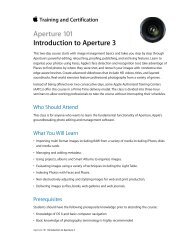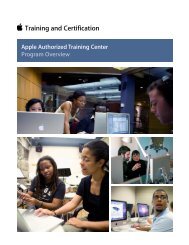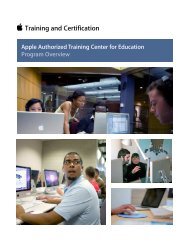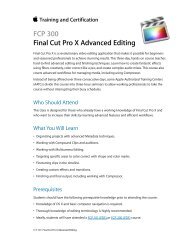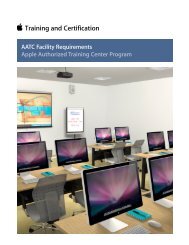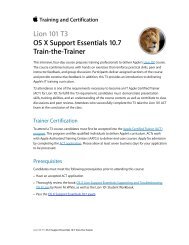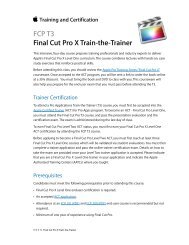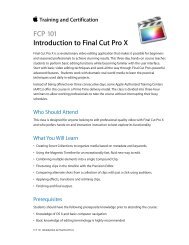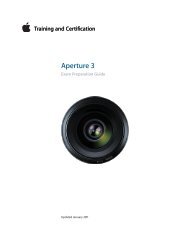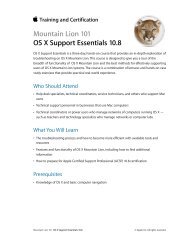OS X Support Essentials 10.8 - Training - Apple
OS X Support Essentials 10.8 - Training - Apple
OS X Support Essentials 10.8 - Training - Apple
You also want an ePaper? Increase the reach of your titles
YUMPU automatically turns print PDFs into web optimized ePapers that Google loves.
<strong>OS</strong> X <strong>Support</strong> <strong>Essentials</strong> <strong>10.8</strong> Exam Preparation Guide<br />
Part Seven: Network Services<br />
Upon completion of Part Seven, “Network Services” in <strong>OS</strong> X Mountain Lion<br />
<strong>Support</strong> <strong>Essentials</strong>, you should be able to complete the following tasks. Five<br />
items from Part Seven are included in the pool of exam questions.<br />
Questions are drawn randomly from the following objectives:<br />
• Given a Mac with <strong>OS</strong> X installed, access network services.<br />
• Identify the network services provided by iCloud on a Mac running<br />
<strong>OS</strong> X Mountain Lion.<br />
• Describe the tools and methods used to configure network services for<br />
applications such as Safari, Mail, Messages, Contacts, Calendar, and<br />
Finder.<br />
• Describe the tools and methods for configuring sharing services.<br />
• Compare and contrast the tools and methods used for screen sharing.<br />
• Given a Mac with <strong>OS</strong> X installed, sharing services configured, a network<br />
connection, and a scenario where sharing services aren’t working as<br />
expected, troubleshoot the configuration and connections to restore<br />
the service connection.<br />
• Describe the tools and methods used to mount and unmount network<br />
share points.<br />
• Use /Network to discover file services available on the network.<br />
• Use the “Connect to Server” menu option in the Finder to access files<br />
from each of the five types of accessible file servers.<br />
• Describe the relationship between client software, client<br />
configurations, server software, and server configurations relative to<br />
network service access.<br />
• Describe the relationship between a network service and a network<br />
port.<br />
• List three troubleshooting techniques for issues involving failure to<br />
connect to various network services.<br />
• List the five types of file servers accessible via the “Connect to Server”<br />
menu option.<br />
• List service discovery protocols supported by <strong>OS</strong> X.<br />
• Describe how <strong>OS</strong> X uses dynamic service discovery protocols to access<br />
network services.<br />
• Describe how items inside /Network in <strong>OS</strong> X are populated and<br />
organized.<br />
• Describe common issues when connecting to file sharing services<br />
using <strong>OS</strong> X.<br />
• List issues with metadata/file forks, and issues with connecting to file<br />
servers that don’t support AFP 3.1.<br />
• Given a Mac with <strong>OS</strong> X installed, configure a firewall.<br />
• Describe how firewalls work in <strong>OS</strong> X.<br />
40



